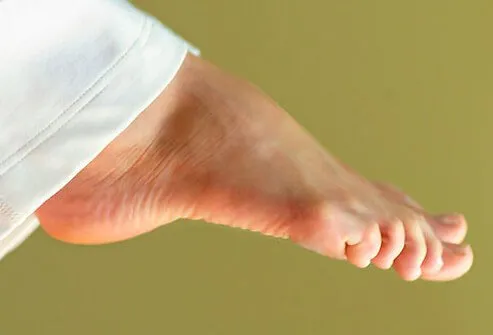Less Pain, More Energy

Don't let the muscle pain and fatigue of fibromyalgia keep you on the sidelines. You can -- and should -- get moving. A few simple tweaks to common exercises can boost your energy, ease pain and stiffness, lift your mood, and improve your sleep. Check with your doctor before you start.
Get Warmed Up

Take time to loosen your muscles first. It will help you avoid injury. Start with your feet and work your way up. Make slow, circular motions (clockwise and counter-clockwise) with all your joints until they move easily. If it hurts, stop.
Stretch More, Hurt Less

Daily stretches can help your joints move more smoothly. You may hear this called range of motion. Focus on the big muscle groups: calves, thighs, hips, lower back, and shoulders. Hold the stretch for 30 seconds. Stop if it hurts. Try to stretch two to three times a week.
Calf Stretches

Here's how to do this move. Face a wall. Place your palms flat on the surface, one foot forward, and one foot back. Leave your heels on the floor and lean forward. Feel the pull in your calf and the Achilles tendon at the back of your ankle. Hold the position for 30 seconds. Switch legs and repeat. Stretch each calf three times.
Aerobic Exercise

This is one of the best ways to take charge of your fibromyalgia. An aerobic exercise uses your large muscles over and over for a set period of time. Walking is the easiest, and you don’t need any special tools other than a good pair of shoes. Swimming and biking are also good options. The trick is to find something you like and do it for 30 minutes a day, 5 days a week. If you need to start with 10 minutes and work your way up, do it.
Boost Your Muscles and Mood

Strength exercises can lower your pain and help with depression. You don’t need to lift a heavy barbell. What matters here is the range of movements you take your muscles through. Before you start, get tips from a trainer at a fitness center. Ask how to use handheld weights, elastic bands, or strength-training machines the right way, so you don’t injure yourself or make your pain worse.
Isometric Chest Press

If regular strength-training hurts, try exercises called isometrics. You’ll tense your muscle without any visible movement. Here’s how: Hold your arms at chest height. Press your palms together as hard as you can. Hold for 5 seconds, then rest for 5 seconds. Do this five times. Slowly build to holding the press for 10-15 seconds at a time. If this move is painful, ask a trainer to show you another isometric chest exercise.
Isometric Shoulder Extension

Stand with your back against a wall and your arms at your sides. With your elbows straight, push your arms back toward the wall. Hold for 5 seconds, and then rest. You can repeat this 10 times. If the move hurts, ask a trainer to show you another isometric shoulder exercise.
Ice Your Pain

If you overdo it during your workout, a cold compress can help. It eases pain and swelling. You can wrap the cold pack in a towel so it isn’t right against your skin. Leave it on for 20 minutes, then take if off for the same amount of time.
How Much Is Enough?

If you’re just getting started with exercise, choose low- to moderate-intensity activities. Your choices include mall walking, swimming, water aerobics, using a kickboard in a pool, yoga, tai chi, or biking. Start slow and increase the time and intensity as you can. Again, your goal is to work up to 30 minutes a day, 5 days of the week.
Daily Activities Count

Household chores like mopping floors, washing windows, and mowing the yard are exercise. So are fun things like gardening and playing with kids or grandkids. Anything that gets you moving can help when it comes to boosting fitness and easing your symptoms.
Yoga for Body/Mind Fitness

This blend of stretches and meditation can also help you get more fit. The postures you hold, called asanas, ease aches and pains. And the exercises that teach you to focus your thoughts, called dharana, can help you overcome fibro fog. Meditation keeps your mind in the present, which help you handle pain.
What Type of Yoga Works Best?

Viniyoga is a type that mixes deep breathing with gentle stretches. It's a great way to improve your health. You’ll need to find a good teacher who knows how to work with someone who has fibromyalgia. Check with your local community center or gym. Or ask your support group, an online fibro community, or your doctor for suggestions.
Qigong for Muscle Pain

This ancient practice is known as the "mother of Chinese healing," and it’s pronounced chee-gong. It combines meditation, dance, movement, and breathing techniques. Studies show it can improve energy, lessen fatigue, and ease pain. Visit the National Qigong Association’s web site for more information.
Tai Chi Boosts Flexibility

This exercise helps you relax. Think of it as "meditation in motion," with gentle, flowing movements instead of forceful actions. It can lower your stress, improve balance and flexibility, and build muscle strength. Sign up for a class at your fitness or community center.
Heat Can Help

Use it before and after a workout to ease any pain and stiffness or to reduce muscle spasms. Heating pads, heat lamps, and warm baths or wash cloths are all good choices. Use the heat for 20 minutes, then stop for 20 minutes before you try it again.
Fibromyalgia Pain Relief: Stretching and Strength Exercises
This tool does not provide medical advice. See additional information: 
© 1996-2024 WebMD, LLC. All rights reserved.
Source slideshow on WebMD